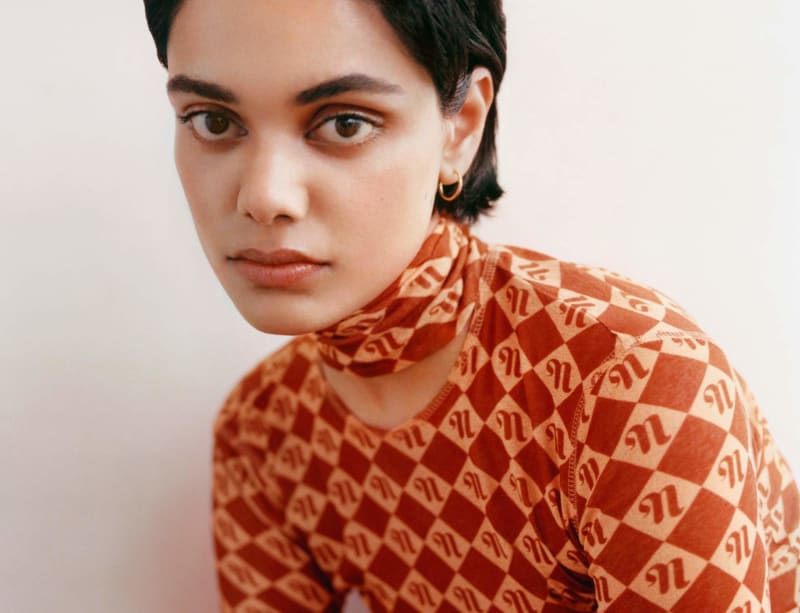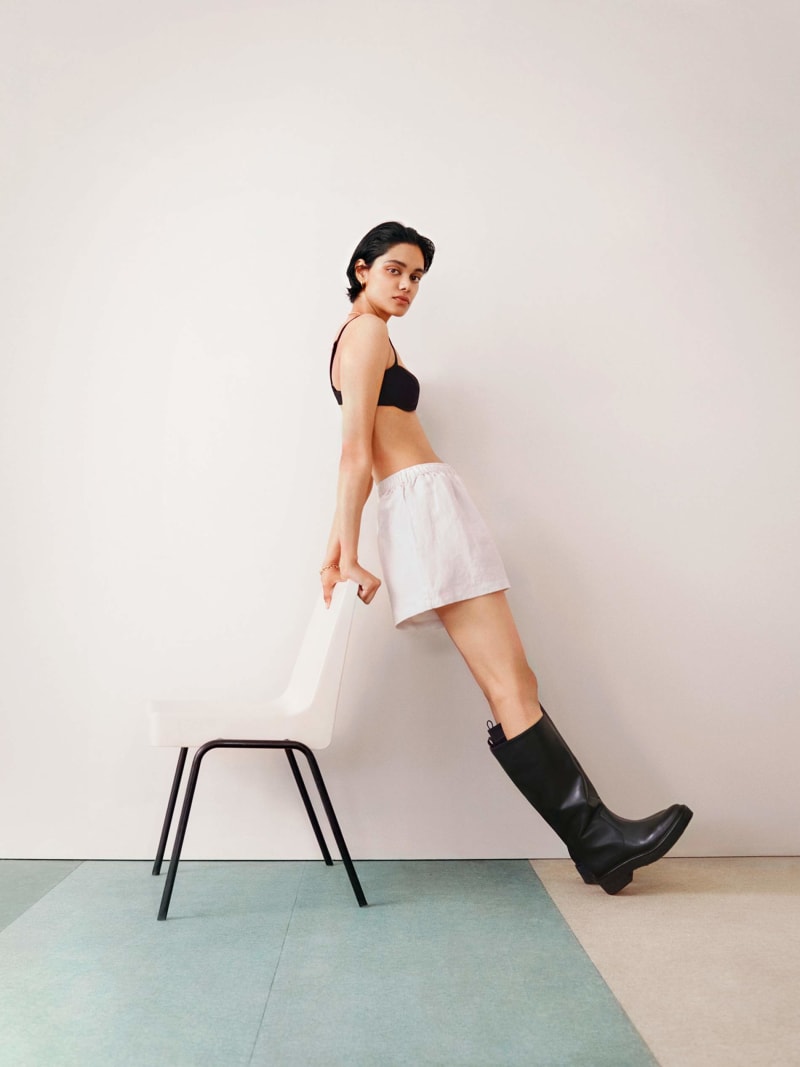Force Of Nature: Zinnia Kumar
PORTER Magazine, 2021
From combating colorism and driving diversity in the world of ecology to challenging social injustices and deconstructing beauty politics, model Zinnia Kumar is propelling forward conversations around sustainability – one carefully considered campaign at a time.

Photo by Rodrigo Carmuega for PORTER.
Zinnia Kumar catches me off guard when she tells me the moniker she had growing up: “My nickname was Gollum,” the 26-year-old model, ecologist and writer shares while recounting, over Zoom, the first time she was scouted by an agent at a makeup counter in her home town of Sydney, Australia. Gollum – the haunting character from Lord of The Rings? “It’s because I have big eyes,” she clarifies.
While there’s nothing Sméagol-like about her eyes, it’s true that they’re striking in size. There’s a detectable watchfulness to them as well, a quality Kumar attributes to being a lifelong introvert. “I was this really intense five-year-old just watching everyone and seeing everything and questioning it,” she says. That intensity is concentrated in her gaze, which pierces through my screen with the same penetrative effect it has when featured on covers and campaigns. It’s also what propelled Kumar into the field of science, where observation and analysis are seminal to her practice as a chartered ecologist and evolutionary biologist. These are the two worlds between which Kumar oscillates, and it’s in the moments where her professional paths collide that she finds most purpose.
“Combining my passions with the [ability] of fashion to access millions of people is really powerful,” she says. “My aim with everything is to educate people so they can choose to take action… or at least to continue the conversation.”
Those conversations can range from nuanced discussions on beauty politics to a deep dive into the global environmental repercussions of consumerism. Kumar, who is of Indian descent, addresses these topics without restraint on her Instagram account, where she has an audience of more than 400,000 followers. Interspersed between posts highlighting responsible design initiatives by an impressive roster of brand partners, fashion shoots and the occasional selfie are infographics condemning the media’s orientalist depictions of South Asians and evidence of damaging, even lethal, cultural messaging on race that has been disseminated throughout history via advertising and literature. She is especially vocal about the social, psychological and economic disparities perpetuated by colorism, and how those disadvantages have been exploited for profit.
When beauty shifted to tanning for European women in the mid-1920s, skin-bleaching products lost favor in Europe and the US, so they were repackaged and shipped off to foreign countries to be consumed by people of color,” Kumar explains. “Pharmaceutical companies were preying on people’s vulnerabilities and their desire to not be ostracized from society. The ads really tricked people of color into thinking that if you used these products you could avoid those power imbalances.”
Kumar speaks on these issues with a breadth of knowledge she’s acquired from the undergraduate research on human attractiveness she conducted in Sydney before moving to London to further her studies in industrial, organizational and business psychology. With a focus on sustainability and corporate social responsibility, Kumar channels her learnings into growing her social-impact consultancy and production start-up, The Dotted Line. Her mission is to effectively increase a sense of belonging among non-white professionals by fostering safer, more inclusive workplaces. She also has a podcast in the works, set to launch in the fall, which will interrogate exclusionary systems in fashion (she offers the casting process as an example), and she’s hired an entirely South Asian team with which she’s currently producing a documentary on colorism through the lens of those who have experienced it themselves.
Combining my passions with the [ability] of fashion to access millions of people is really powerful.
“I think it’s about taking a step back and seeing the problem as a whole and understanding it, but from a human level. The only way that can be done is if local people who speak the language, who know that culture, who have lived that culture, can talk about it,” Kumar says, stressing the need for diversity in film-making, both on and off camera. “That will give us back our power.”
Widening the scope of representation in fashion beyond the runway, she points out, is just as essential to improving professional outcomes for creatives of color. Would she have appeared in an Off-White campaign – her first major high-fashion gig – if its founder and CEO Virgil Abloh wasn’t a Black man who has navigated the challenges of breaking into a predominantly white industry himself? Probably not, Kumar opines. “I think part of the reason for that access, for me to even be able to do that, was actually Virgil, because he is a person of color as well and it’s all about creating those spaces [for each other].”
Born to Indian parents in a family of farmers who have been in Australia since 1859, Kumar has witnessed how lasting vestiges of colonialism are transmitted from one generation to the next in the form of depleting natural resources and Euro-centric beauty ideals that valorize whiteness. Her commitment to raising awareness about the latter stems from childhood memories of her mother struggling to find a shade of foundation suitable for her darker skin tone, and of her grandmother insisting she should avoid the sun.
Of the discrimination that followed her mother beyond the aisles of their local drugstore, Kumar says: “That’s a type of violence that people are facing because they’re implicitly being told, ‘You’re not good enough to access beauty. We don’t even think about you.’” It’s through unpacking the injustices survived by her mother and grandmother that Kumar has been able to grapple with the ways in which they’ve resurfaced in her own life. “For my grandmother, who was married off at a very young age because she was the darkest in her family and they worried she would never find a husband, lighter skin equated to a level of freedom and privilege that she wanted me to access, and the only way she could verbalize it was by saying stay out of the sun.” Devastatingly, Kumar says that she has even lost loved ones to suicide because of the heavy burden of prejudice. “These stories aren’t unique, they’re just not told,” she adds.
While Kumar acknowledges the privilege her lighter complexion has afforded her compared to other members of the South Asian community, she is no stranger to the constant reminders of her otherness that chipped away at her self-esteem as a teenager. She references the overwhelming sadness and inadequacy triggered by realizing she would never look like the women celebrated in mainstream media. These feelings were reaffirmed in the early stages of her modeling career, when she was rejected by countless agencies.

Photo by Rodrigo Carmuega for PORTER.
Fast-forward about a decade, however, and Kumar has graced many a cover. She became the first Indian woman to cover Vogue Australia in its 62-year history. Plus, she’s the first ecologist to have appeared on any Vogue cover, ever. It’s a milestone she sees as important not only for future generations, but for those who came before her, too. Aside from bringing her stoic grandmother to tears, Kumar says the most rewarding part has been receiving messages from girls of similar racial backgrounds, and even young women in STEM, telling Kumar that seeing her has made them feel visible as well.
Despite the covers, campaigns and style clout that comes with such accolades, Kumar has not abandoned her minimalist mentality. She believes that sustainability in fashion is not just about the materials your clothes are made from, but how those clothes are used and respected. Kumar has always purchased pieces she intends on wearing forever – these days, for instance, she’s sporting a bold-shouldered Acne Studios blazer on repeat.
Although her Twitter is peppered with urgent calls for more meaningful diversity in the environmental sector (Kumar references that, in the UK, 97 percent of eco-professionals are white), she does attribute her love for conservation biology to watching David Attenborough documentaries as a child. However, it was her fieldwork in the Australian bush that ultimately transformed Kumar’s perception of conscious consumption – particularly the discovery of a deceased cormorant bird underneath a heap of plastic on a remote island. “Something I remember quite vividly, which I [apply to] fashion, is that one small action may have a huge impact thousands of miles away. A single choice that we make can have an impact elsewhere, and that’s what I try to bring into my work.”
Kumar’s expanding platform proves that people are listening. They care what she has to say, whether it’s about protecting our planet, combating social injustices or rejecting archaic beauty standards. And for that, she’s grateful. “When I leave Earth, I want to make sure I’ve left it a tiny bit better than when I arrived – even if it’s just for one person, because otherwise I feel like I’ve just taken up space and used resources and done nothing here. I guess that’s the philosophy behind all this.”